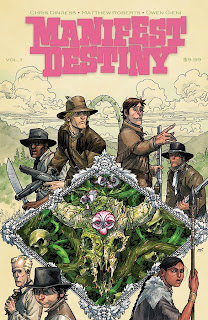 The Australian Outback after a nuclear
and biological disaster is dominated by three city-states, each of which
controls one vital resource- food, fuel, or ammunition. As part of a
periodic exchange of goods one of these city-states, the Citadel, manages a heavily guarded merchant
caravan that connects the three city-states. Despite being the best
source of water (via a well-pressured underground spring) and food, the Citadel
struggles with radiation and birth defects among its population. The
leader of the Citadel manages the social tensions generated by these birth
defects in three ways. First, by enslaving healthy men and using them as
living blood banks. Second, by enslaving healthy women to act as brood mothers
in hopes of birthing a generation of fit children. Finally, by creating a
Norse-inspired cult that reveres death in combat before succumbing to
radiation-linked diseases.
The Australian Outback after a nuclear
and biological disaster is dominated by three city-states, each of which
controls one vital resource- food, fuel, or ammunition. As part of a
periodic exchange of goods one of these city-states, the Citadel, manages a heavily guarded merchant
caravan that connects the three city-states. Despite being the best
source of water (via a well-pressured underground spring) and food, the Citadel
struggles with radiation and birth defects among its population. The
leader of the Citadel manages the social tensions generated by these birth
defects in three ways. First, by enslaving healthy men and using them as
living blood banks. Second, by enslaving healthy women to act as brood mothers
in hopes of birthing a generation of fit children. Finally, by creating a
Norse-inspired cult that reveres death in combat before succumbing to
radiation-linked diseases.
Enter the film’s main conflict- the
Citadel’s best warrior and caravan leader is a woman kidnapped from a distant
matriarchal city-state as a child, who wants to free the brood mother sex slaves
and with them return to her homeland across the desert. As an experienced
caravan leader she is familiar with terrain, the unusual weather hazards, and
has made deals with the scattered bandits and tribes along the way for
protection. When the caravan leader makes her break for her homeland we
see start to see the importance of healthy potential mothers to the new society
and the strong connections between the city-states as all three bring their
warriors together to recapture and re-enslave the brood mothers. This sets
up the film’s ominous question: what is more important, the continuation of a
stable society, or the personal freedom of individuals? In the finest
tradition of the Western films, a lone silent gunslinger enters the plot to
challenge the assumptions of the main characters and drive them to greater
levels of personal understanding and introspection.
That’s Mad Max: Fury Road in a
nutshell. Or, it’s a two hour car chase
with almost no dialogue.
Honestly, it’s both. There is a
rich story going on in Mad Max: Fury Road, and it’s right there for any
viewer to note. But you can also completely ignore that story and go
right for the constant rev of engines and beautifully choreographed mayhem
(Cirque du Solei did some of the stunts in the big fights). If director
George Miller did a film of nothing but two hours of motorcyclists in the Namib
desert I would pay to see that, but have them jumping over trucks on
fire? Awesome.
My favorite part of Mad Max: Fury
Road came about 2/3 of the way through, in a brief pause in the action, as
Max Rockatansky himself spoke his first full line of dialogue: “Hope is a
mistake. If you don’t fix what’s broke, you’ll go insane”.
This film is brilliant.














